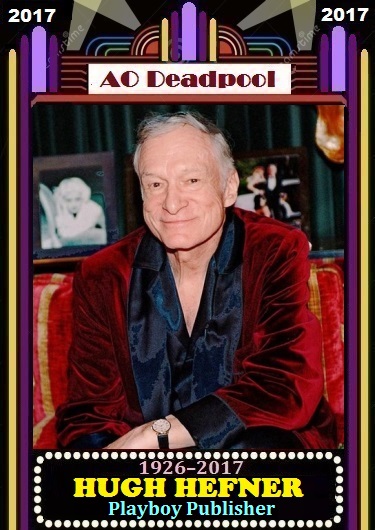He wanted to call it Stag Party, but that title was already
taken. So the magazine he founded in 1953 was called Playboy, and it changed the rules.
Hugh Hefner, who died on September
27, at 91, was the man who made America safe for pornography, many critics and
advocates said. To others (including himself) he was the ultimate lifestyle
exemplar, a more louche Martha Stewart, and the magazine was was akin to a
personal journal.
The editorial mix in Playboy—articles
on travel, stereo equipment, fiction by famous authors such as Ian Fleming and
Kurt Vonnegut Jr., and especially the nude pictures—constituted "a
projection of my own dreams, desires and aspirations," Mr. Hefner told The Wall Street Journal in 1971. Circulation
peaked at 7 million in the early 1970s, and Playboy
branched out into a short-lived empire of nightclubs, hotels, and casinos where
scantily clad "Bunny" waitresses added to the fantasy ambience.
Mr. Hefner claimed that there was
plenty of repression in his background. His middle-class parents "were
very good people, with high moral standards—but very repressed," he told
the Hollywood Reporter in 2011. "There
was no hugging and kissing in my home." Yet when, as a former copywriter
for Esquire, Mr. Hefner set out to
start a new kind of men's magazine, his Methodist mother helped bankroll the
project.
The first issue featured Marilyn
Monroe—"as famous as Dwight Eisenhower and Dick Tracy," Playboy crowed—in nude photos taken a
few years earlier. The magazine flew off shelves at magazine stands.
Wrote Mr. Hefner in the first
issue, "We enjoy mixing up cocktails and an hors d'oeuvre or two, putting
a little mood music on the phonograph, and inviting a female acquaintance for a
quiet discussion on Picasso, Nietzsche, jazz, sex."
Whether or not discussion with
female acquaintances was on the menu, ogling them certainly was. And the Playboy man looked pretty good too,
thanks to Hef's fashion tips.
"The solution to the world's
problems is to get material things to more people—to give everybody the Good
Life," Mr. Hefner told The Wall
Street Journal in 1971.
The party kept growing at the
upstart publication. Mr. Hefner divorced his first wife in 1959 and moved into
the first Playboy Mansion, in Chicago.
Soon there was the first Playboy
Club, and a Playboy TV show that
featured black jazz artists mingling with white musicians—a rarity in those days.
By the 1970s, Mr. Hefner was jetting around the country in the Big Bunny, a
customized black DC-9.
But mostly he stayed home at the
mansion, clad externally in pajamas and working on the magazine in binges
fueled by dexedrine and Pepsi. Never much interested in the business side of
things, he turned the company over to his daughter, Christie Hefner, in the
1980s. Not until 2011 did he return to rescue what remained, taking the
magazine private in a deal valued at $200 million. By then most of Playboy's still-substantial revenue was
generated by licensing deals rather than circulation or affiliated businesses.
It has been observed that the
models in Playboy didn't change much
over the years, mainly top-heavy blondes that Mr. Hefner insisted were the
aesthetic equivalent of "the girl next door," albeit without pores.
Also unchanging was Mr. Hefner's taste in music (big-band jazz), or in much of
anything else.
Weeks at the mansion were tightly
regimented. Each night was devoted to a specific amusement: cards one night,
backgammon the next. Friday was classic-movie night, when he screened oldies—Casablanca
was his favorite movie.
A rotating series of official
girlfriends moved through the scene. He kept them on salary (except for a 10-year
period when he remarried and was, he claimed, faithful to his wife). In later
years he became a vocal advocate of Viagra.
But the prophet of libidinal
fulfillment could seem melancholy.
"I never found the ultimate
soulmate," he told the Hollywood
Reporter in 2011. He would lie in death next to Marilyn Monroe, his first
centerfold; he had long since purchased a mausoleum next to hers.
Free pornography had long left Playboy in the dust, and the magazine's
pictorials—still chosen by Hef until the end—had a retro feel; even its cable
channel specialized in a product more smutty than hardcore.
Among Mr. Hefner's regrets was that
feminists never really cottoned to his message of personal liberation, despite
the voluminous Playboy Philosophy that he cobbled together in the magazine's early
days.
Feminists had a point when they
claimed that Playboy objectified them,
much as it displayed calfskin-lined ice buckets and single-malt Scotch. But Mr.
Hefner had a point that the magazine helped lead the fight for personal
autonomy in speech, sex, and just about everything else.
'Twas ever thus. Hugh Hefner and
his fantastically popular magazine encapsulated many of the struggles and much
of the bliss of postwar America, struggling with its newfound freedoms.
"I started a magazine that
changed everything," he told Esquire
in 2013.--Obitsman
All content
(c) 2005-2017 alt.obituaries Deadpool. All rights reserved.
